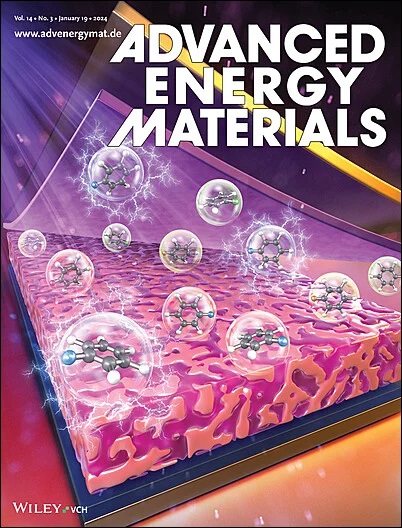有机和钙钛矿太阳能电池的配位定向界面组装
IF 24.4
1区 材料科学
Q1 CHEMISTRY, PHYSICAL
引用次数: 0
摘要
小分子材料在界面处表现出的超分子组装对于控制光伏电池内部的电荷输运动力学和光场特性具有关键意义。然而,对这种装配行为的有限理解和精确控制对这种材料的合理设计和应用提出了挑战。本文设计了两个基于吡嗪的富氮共轭分子。与PCN不同,EPCN的化学结构使其分子间相互作用分布更加均匀,因此EPCN的组装过程受到控制和平衡。因此,引入额外的配位力来调节PCN的不规则组装,获得尺寸合适的均匀半球形纳米点。pcnzr的加入促进了电荷传输,并利用了有效的光散射效应,在有机太阳能电池中实现了19.1%的效率。此外,配位组装特性使PCN具有缺陷钝化和费米能级对准的功能,在1.55 eV钙钛矿太阳能电池中的效率分别为25.4%。利用这些发现,最佳的4 - T钙钛矿-有机串联装置产生25.43%的冠军效率。这项工作通过结构裁剪和金属协调展示了精确的界面组装控制,为有机和钙钛矿光伏电池中组装界面材料的材料设计和应用提供了有价值的见解。本文章由计算机程序翻译,如有差异,请以英文原文为准。
Coordination‐Directed Interfacial Assembly for Organic and Perovskite Solar Cells
Supramolecular assembly exhibited by small molecule materials at interfaces holds a pivotal significance in manipulating the charge transport dynamics and light field characteristics within photovoltaic cells. However, the limited understanding and precise control of this assembly behavior pose challenges to the rational design and application of such materials. Here, two pyrazine‐based nitrogen‐rich conjugated molecules is designed. EPCN exhibits a controlled and balanced assembly process due to its more even distribution of intermolecular interactions from its chemical structure, unlike PCN. Accordingly, an extra coordination force is introduced to regulate the irregular assembly of PCN, obtaining uniform hemispherical nanodots with appropriate dimensions. The incorporation of PCN&Zr boosts charge transport and leverages an efficient light scattering effect, achieving a 19.1% efficiency in organic solar cells. Moreover, the coordination assembly feature endows PCN with the functions of defect passivation and Fermi level alignment, yielding efficiencies of 25.4% in 1.55 eV perovskite solar cells, respectively. Leveraging these findings, the optimal 4‐T perovskite‐organic tandem device yields a champion efficiency of 25.43%. This work demonstrates the precise interfacial assembly control via structure tailoring and metal coordination, providing valuable insights into the material design and application of assembly interface materials in both organic and perovskite photovoltaics.
求助全文
通过发布文献求助,成功后即可免费获取论文全文。
去求助
来源期刊

Advanced Energy Materials
CHEMISTRY, PHYSICAL-ENERGY & FUELS
CiteScore
41.90
自引率
4.00%
发文量
889
审稿时长
1.4 months
期刊介绍:
Established in 2011, Advanced Energy Materials is an international, interdisciplinary, English-language journal that focuses on materials used in energy harvesting, conversion, and storage. It is regarded as a top-quality journal alongside Advanced Materials, Advanced Functional Materials, and Small.
With a 2022 Impact Factor of 27.8, Advanced Energy Materials is considered a prime source for the best energy-related research. The journal covers a wide range of topics in energy-related research, including organic and inorganic photovoltaics, batteries and supercapacitors, fuel cells, hydrogen generation and storage, thermoelectrics, water splitting and photocatalysis, solar fuels and thermosolar power, magnetocalorics, and piezoelectronics.
The readership of Advanced Energy Materials includes materials scientists, chemists, physicists, and engineers in both academia and industry. The journal is indexed in various databases and collections, such as Advanced Technologies & Aerospace Database, FIZ Karlsruhe, INSPEC (IET), Science Citation Index Expanded, Technology Collection, and Web of Science, among others.
 求助内容:
求助内容: 应助结果提醒方式:
应助结果提醒方式:


